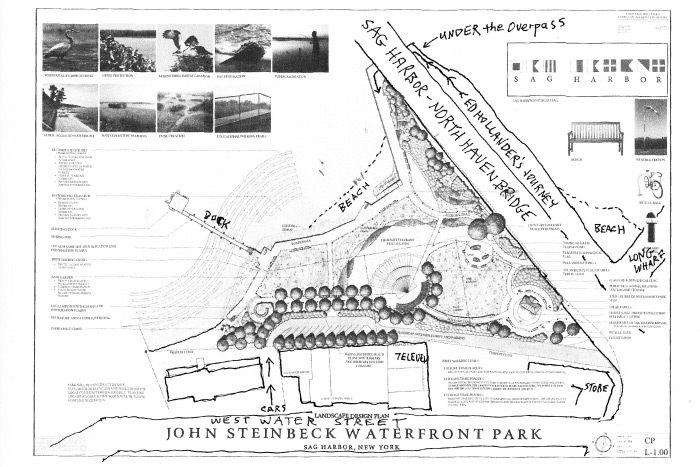Hollander's Journey: Inspiration for a Park in Sag Harbor

In 1994, the landscape architect Ed Hollander drew an interesting architectural plan of a little beach in downtown Sag Harbor that nobody in the village seemed to have known was there. He presented it to the Village Board at one of their meetings.
At the time, the village was planning on prettying up the arc of waterfront just to the left of Long Wharf as you face it from downtown. The Village would soon build a replica of a wooden windmill there, sprinkle some sand, erect three park benches and, at the edge where the grass came down to the water, install a long thin artificial beach of sand. This beach would be 20 feet wide, about 100 yards long, would run parallel to the Lance Corporal Jordan C. Haerter Veterans Memorial Bridge to North Haven on its eastern side and come to an end at the bridge abutment where the bridge rises up and the water flows into the inner harbor under it.
Hollander, a landscape architect, had walked out on the grass of this little beach many times and then, one day, at the abutment, wondered what there might be if you just stepped onto the abutment itself—there is a concrete path there—and by walking under the bridge walk around it to the other side. What could it be? Hollender strolled under and around, and he came upon—sitting in an undeveloped, apparently landlocked shoreline and weeds—the prettiest little arc of a beach nobody knew was there, accessible on foot under the bridge.
Thus he drew up the plan showing this odd access by going under the abutment. Furthermore, he found that the village owned this little beach—not an artificial one but a real one. It was a Columbus discovers America moment.
The Village was distracted at that time by this other plan at Long Wharf, so they just put Hollander’s discovery into a filing cabinet. And there it lay for 15 more years. Then, for new reason, a few people started talking about it.
Plans were afoot for a private developer to build condominiums facing out onto this little beach. The beach wouldn’t be landlocked anymore. You would obtain access to it from the other way, from behind the 7-Eleven. But it would mostly be for the condominium people. Reading about that, I thought, Wow, I thought I knew every nook and cranny in Sag Harbor, but I never knew about this little beach. So I got on my hiking shoes, put on a backpack and with my wife headed out under the abutment, or, as Alice said, down into the rabbit hole.
It’s very interesting back there, not the least reason being the bugs and flies and bushes you have to push through to see the whole thing. As we looked at it, we saw that adjacent to it was a white concrete ruin of a building with the ruin of a dock. It must have been a fishing station. And maybe before that, an old ferryboat landing station from a time before there had been a bridge.
The North Haven bridge was originally constructed as a public works project during the Great Depression in the 1930s. Before that, a more rickety bridge existed, and before that, ferries took passengers, freight and even horse-drawn carriages back and forth between a dock at this beach and a corresponding dock on the island of North Haven on the other side. Thus these ruins remain. There is also a broken down bit of road leading, parallel to that building, to nowhere.
Soon I found out there was more history. An old railroad spur had been there. Between 1910 and 1930, train tracks went from Bridgehampton to Sag Harbor. People could come out from the city on the train, take the spur to Sag Harbor, get off at this end of the spur and there you were, with a ferry waiting to take you to North Haven. It’s in the history books. Another set of tracks went out Long Wharf. I tried walking further onto West Water Street through the brush. It’s blocked. That would be opened for the condominiums. If there were condominiums.
Last week, after numerous meetings with Hollander and the public, the village announced it is seriously exploring taking over this entire two and a half acres of privately owned land backing up to the beach by eminent domain.
I don’t know if the modest attention drawn to the area by the “discovery” of this little beach caused the developers to propose the condominiums or if it was the other way around, but now there are two conflicting proposals for what should go on here.
Negotiations began between the village and the developers last year, but they got nowhere. The property owners had said they proposed a public green space as part of the development, but they are not interested in selling. As a result, the Village has considered this bold move to take it all and make it an extension of the little park on the other side of the bridge. Walk under the bridge. On one side the beach looks out to sea, on the other, the beach looks out over the inner harbor to the sunset.
Eminent domain is where a government body expropriates private property, for fair-market-value payment, because it is in the way of a needed public amenity. It could be property that is needed for a six-lane highway. It could be property that is needed for a professional baseball stadium. It needs a good reason to be taken that way. A government body cannot just go around like some big chomping machine and take people’s property away from them—but then they can and do in such incidences as described above.
The State of New York has to agree that there is a unique need to take over a property by eminent domain. In this case, a taking for a public park adjacent to an existing smaller public park in the middle of downtown seems a no-brainer. If approval is given, the land is appraised, the money is raised, and the transfer takes place.
Imagine Sag Harbor with this park right down by the water. It will appear as one park, with the bridge to North Haven dividing it in two. Access on foot to either side of the park from one to the other will be by walking under the bridge.
Sag Harbor stands at a fork in the road, almost literally. It can be a resort town with only minimal greenery and parkland down by the waterfront, for use mostly by condominium owners. Or it can be a resort town with a big waterfront park open to all, busy with citizens and tourists in the summertime enjoying the day and waiting for the sun to set over the Sag Harbor boat basin and inn down the way.
Some villages in these parts have lots of open space downtown. Others have only a little. All are historic and gorgeous. But only one of them has a commercial center that sits waterfront, bustling with strollers and, on its periphery, has no shopping centers or chain stores as you get to it. That village is the old whaling village of Sag Harbor, and restoring and opening up the waterfront for all is a stupendous idea.
And the name? It’s already been named. It’s the John Steinbeck Waterfront Park, in honor of that village’s most famous citizen.
I love it.



